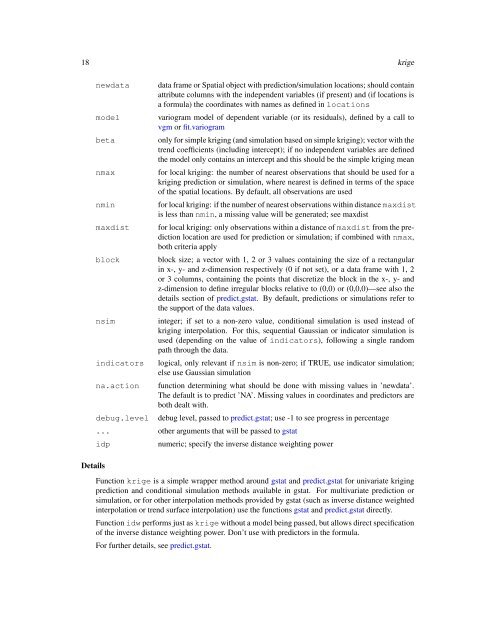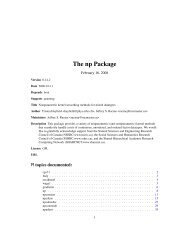The gstat Package - NexTag Supports Open Source Initiatives
The gstat Package - NexTag Supports Open Source Initiatives
The gstat Package - NexTag Supports Open Source Initiatives
You also want an ePaper? Increase the reach of your titles
YUMPU automatically turns print PDFs into web optimized ePapers that Google loves.
18 krigenewdatamodelbetanmaxnminmaxdistblocknsimindicatorsna.actiondebug.leveldata frame or Spatial object with prediction/simulation locations; should containattribute columns with the independent variables (if present) and (if locations isa formula) the coordinates with names as defined in locationsvariogram model of dependent variable (or its residuals), defined by a call tovgm or fit.variogramonly for simple kriging (and simulation based on simple kriging); vector with thetrend coefficients (including intercept); if no independent variables are definedthe model only contains an intercept and this should be the simple kriging meanfor local kriging: the number of nearest observations that should be used for akriging prediction or simulation, where nearest is defined in terms of the spaceof the spatial locations. By default, all observations are usedfor local kriging: if the number of nearest observations within distance maxdistis less than nmin, a missing value will be generated; see maxdistfor local kriging: only observations within a distance of maxdist from the predictionlocation are used for prediction or simulation; if combined with nmax,both criteria applyblock size; a vector with 1, 2 or 3 values containing the size of a rectangularin x-, y- and z-dimension respectively (0 if not set), or a data frame with 1, 2or 3 columns, containing the points that discretize the block in the x-, y- andz-dimension to define irregular blocks relative to (0,0) or (0,0,0)—see also thedetails section of predict.<strong>gstat</strong>. By default, predictions or simulations refer tothe support of the data values.integer; if set to a non-zero value, conditional simulation is used instead ofkriging interpolation. For this, sequential Gaussian or indicator simulation isused (depending on the value of indicators), following a single randompath through the data.logical, only relevant if nsim is non-zero; if TRUE, use indicator simulation;else use Gaussian simulationfunction determining what should be done with missing values in ’newdata’.<strong>The</strong> default is to predict ’NA’. Missing values in coordinates and predictors areboth dealt with.debug level, passed to predict.<strong>gstat</strong>; use -1 to see progress in percentage... other arguments that will be passed to <strong>gstat</strong>idpDetailsnumeric; specify the inverse distance weighting powerFunction krige is a simple wrapper method around <strong>gstat</strong> and predict.<strong>gstat</strong> for univariate krigingprediction and conditional simulation methods available in <strong>gstat</strong>. For multivariate prediction orsimulation, or for other interpolation methods provided by <strong>gstat</strong> (such as inverse distance weightedinterpolation or trend surface interpolation) use the functions <strong>gstat</strong> and predict.<strong>gstat</strong> directly.Function idw performs just as krige without a model being passed, but allows direct specificationof the inverse distance weighting power. Don’t use with predictors in the formula.For further details, see predict.<strong>gstat</strong>.
















